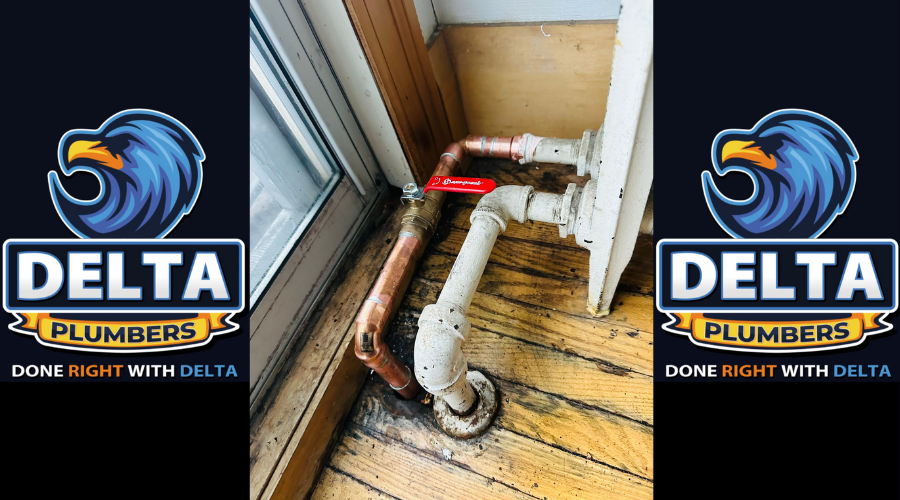Shut-off valves are an essential part of any plumbing system. They allow you to control the water flow to specific areas of your home or business, making maintenance and emergency repairs more manageable. However, like all plumbing components, shut-off valves can wear out over time and may need replacement. This comprehensive guide by Delta Plumbers will walk you through everything you need to know about shut-off valve replacement. From costs and installation tips to determining responsibilities, we’ll answer your most pressing questions about this critical plumbing fixture.

Picture Source – Delta Plumbers
How Much Does It Cost to Replace a Shut-Off Valve?
The cost of replacing a shut-off valve depends on various factors, such as the type of valve, the complexity of the replacement, and the professional services hired. Below is a breakdown of potential costs:
1. Material Costs
The shut-off valve itself is relatively inexpensive. Depending on the type, you can expect the following price range:
- Plastic Valves: $10–$20
- Brass Valves: $20–$40
- Stainless Steel Valves: $30–$50
Brass and stainless-steel valves are more expensive but are highly durable and recommended for long-term use.
2. Labor Costs
Hiring a professional plumber ensures the job is done safely and correctly. Plumbers typically charge:
- $50–$150 per hour, depending on their experience and your location.
Most shut-off valve replacements can be completed in about an hour, but additional repairs or challenges could increase labor costs.
3. Potential Additional Costs
- Pipe Repairs: If the pipes connected to the valve are corroded or damaged, they may also need replacement, which could add $50–$200 to the total cost.
- Emergency Services: If the replacement is urgent, expect an additional $50–$100 for emergency service calls.
Investing in high-quality materials and professional plumbing services ensures long-term reliability, saving you from future issues and costly repairs.
Also Read: Bathroom Plumbing Fixtures: The Latest Trends in Canada

Picture Source – Delta Plumbers
Can You Replace a Shut-Off Valve Without Turning Off Water?
While it may seem tempting to avoid turning off your main water supply, replacing a shut-off valve without shutting off the water is not advisable. Here’s why:
1. High-Risk of Property Damage
Water flowing through an open system under pressure can spray uncontrollably, leading to water damage to floors, walls, and furniture.
2. Safety Concerns
High-pressure water can pose a safety hazard, especially when working with sharp tools and plumbing equipment.
3. Incomplete Repairs
Installing a new valve while water is still flowing can result in a poor connection, leading to leaks or further damage down the line.
Best Practice
Always turn off the main water supply before starting work. If you are unsure how to do this or need assistance, Delta Plumbers is equipped to handle this process with ease, ensuring a safe and efficient replacement.
Also Read: How to Replace a Toilet: Step-by-Step Guide

Picture Source – Delta Plumbers
How to Remove an Old Shut-Off Valve?
Removing an old shut-off valve requires the right tools and a step-by-step approach. Follow these detailed instructions or hire a professional for peace of mind:
1. Turn Off the Main Water Supply
Locate your home’s main shut-off valve, typically near the water meter or where the water line enters your home, and turn it off completely.
2. Drain the System
To avoid water spills, open a faucet downstream from the shut-off valve to release any remaining water in the pipes.
3. Gather Tools
You’ll need:
- Adjustable wrench or pipe wrench
- Pipe cutter (if the valve is soldered)
- Towels or a bucket to catch residual water
4. Loosen the Valve
- For threaded valves: Use an adjustable wrench to loosen the compression nuts connecting the valve to the pipes.
- For soldered valves: Carefully cut the pipe just below the valve using a pipe cutter.
5. Clean the Pipe Ends
Remove debris, old thread sealant, or solder residue from the pipe ends to ensure a tight fit for the new valve.
Professional Help
Delta Plumbers ensures a clean and precise removal process, avoiding damage to surrounding pipes and fixtures.
Also Read: Bathroom Vanity and Sink: How to Install

Picture Source – Delta Plumbers
How Often Should Shut-Off Valves Be Replaced?
Shut-off valves are built to last, but their longevity depends on materials, usage, and environmental factors.
Lifespan of Shut-Off Valves
- Plastic Valves: 5–10 years
- Brass or Stainless-Steel Valves: 20–30 years
Signs You Need Replacement
- Leaking Valve: Even small drips can indicate wear.
- Difficulty Turning: If the valve becomes stiff or stuck, it’s time for a replacement.
- Corrosion: Rust or discoloration is a clear sign the valve is deteriorating.
- Reduced Water Flow: A malfunctioning valve can restrict water flow.
Routine inspections by Delta Plumbers can help detect issues early, ensuring your valves remain in good condition.
Also Read: Importance of Regularly Cleaning Your Drains

Picture Source – Delta Plumbers
Who Is Responsible for the Water Shut-Off Valve?
Understanding responsibility for shut-off valve maintenance is essential to avoid unexpected repair costs.
Inside the Property
Property owners are responsible for maintaining and replacing shut-off valves located within the home or business premises.
Outside the Property
Valves located near the street, such as curb stops, are typically the responsibility of the municipality or water service provider.
Clarification in Ontario
For homeowners in Ontario, consulting with Delta Plumbers or your local water utility can help clarify ownership and responsibilities.
Also Read: DIY Plumbing vs. Hiring a Professional: The Pros and Cons

Picture Source – Delta Plumbers
How Long Does It Take to Replace a Water Shut-Off Valve?
The time required to replace a shut-off valve depends on factors like the valve’s location, condition, and type.
Typical Replacement Time
Most replacements take 30 minutes to an hour when handled by professionals.
Factors That Can Increase Time
- Corroded Pipes: Old or damaged pipes may require additional repairs.
- Difficult Access: Valves in hard-to-reach areas may take longer to replace.
- Specialty Valves: Installing unique or complex valves can add time.
Delta Plumbers specializes in efficient replacements, minimizing inconvenience while ensuring quality.
Also Read: Install a Laundry Room Sink: The Process

Picture Source – Delta Plumbers
What to Do If Shut-Off Valve Is Broken?
A broken shut-off valve can lead to water leaks and restricted control over your plumbing system. Here’s what you should do:
1. Turn Off the Main Water Supply
If the valve is leaking or non-functional, turning off the main water supply prevents further damage.
2. Call a Professional
Avoid DIY fixes for broken valves, as improper handling can exacerbate the issue. Contact Delta Plumbers for immediate assistance.
3. Temporary Fixes
While waiting for professional help, you can:
- Use plumbing tape or pipe clamps to minimize leaks temporarily.
- Place a bucket under the valve to catch drips and prevent water damage.
Our experienced team ensures that the broken valve is replaced with a durable and reliable solution, restoring your system to full functionality.
Conclusion
Replacing a shut-off valve might seem like a small task, but it plays a significant role in maintaining your plumbing system’s health and safety. From understanding costs and tools to knowing when and how to replace valves, this guide provides everything you need.
For reliable shut-off valve replacement, trust Delta Plumbers. Our team of skilled professionals ensures high-quality service, giving you peace of mind and a leak-free home. Contact us today to schedule an inspection or replacement!









